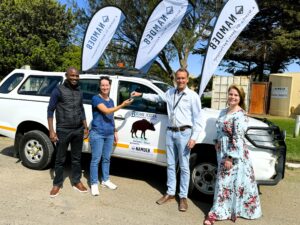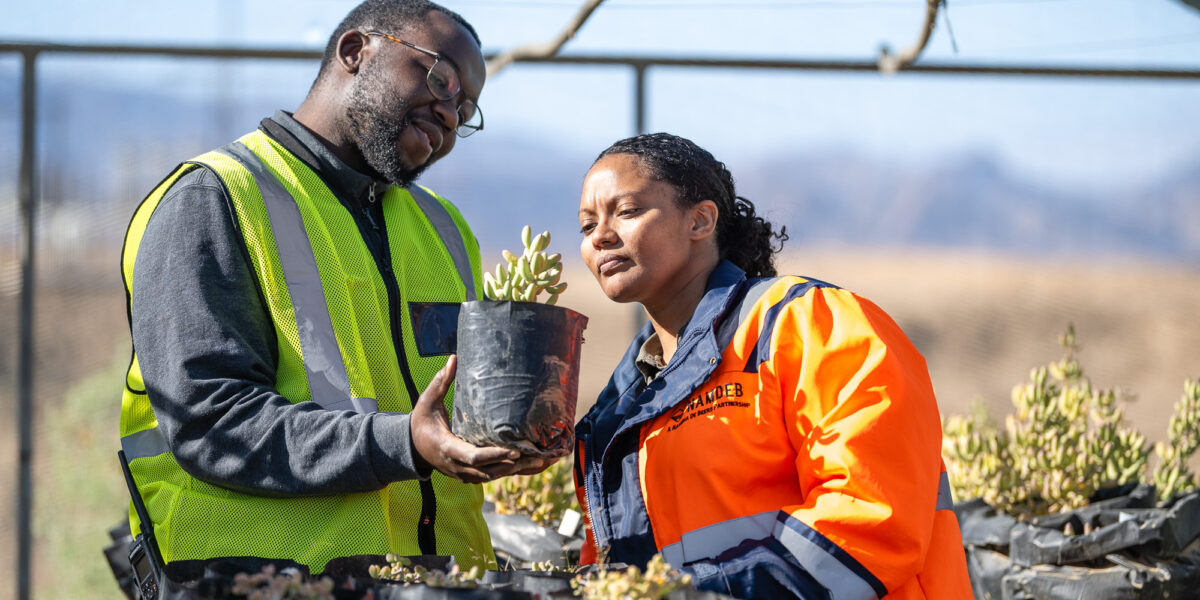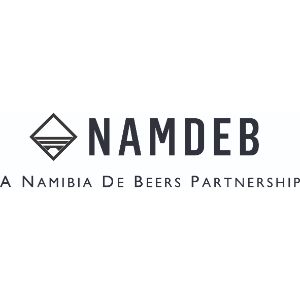Protecting the Natural Environment
Namdeb’s operations are located within the Tsau //Kaeb (Sperrgebiet National Park), adjacent to the Orange River and Namibian Islands Marine Protected Areas. Namdeb’s comprehensive rehabilitation programme addresses a hundred (100) year legacy of mining in the Tsau //Kaeb (Sperrgebiet) National Park. The Company prides itself with a rehabilitation plan aligned with the park’s Land Use Plan. This plan provides for rehabilitation of areas that are mining, nature as well as conservation based.
Namdeb caters for concurrent rehabilitation and continues the focus on various conservation and monitoring as well as historical ecological programs which help minimize the potential negative impact on the environment in which it operates. Namdeb’s Environmental Management Plans are centered on sustainability principles and align to the global call for action to reduce environmental impacts that support decarbonization efforts.
These plans also strengthen the mitigation against climate change risks through advocating responsible water management practices across the operations, contributing to Namdeb’s ambition of becoming carbon neutral by 2030.
Namdeb also spearheaded an ecological restoration programme on the endangered Juttadinteria albata (a succulent endemic to the area) and other red listed species. Implementation of the programme is dependent on the concurrent rehabilitation that is integrated into the mine plan and involves concurrent biophysical rehabilitation, backfilling and landscaping of mined areas. The restoration process involves seed collection through an established onsite nursery, germination and revegetation of the landscaped areas. The restoration work is effective as the project has yielded outstanding results of a 102% plant survival rate with additional natural growth.

Towards a Carbon Neutral Future
In accord with the Namibian Government’s ambitions, Namdeb is actively addressing the detrimental effects of the impact of carbon emissions on climate change. As such Namdeb developed an overarching strategy to ensure it can deliver on its objective to become carbon neutral. This strategy is based on four pillars namely, (1) improving operational efficiency to reduce energy consumed per ton moved (2) replace fossil fuel with fuel produced from renewable sources (3) replace fossil electricity with electricity produced from renewable energy and (4) recover carbon through nature-based solutions for hard-to-abate emissions.
Kerbehuk Ridge Wind Energy Facility
The high potential of the wind resource within Namdeb’s mining license areas provide an opportunity to investigate the use of wind energy. As such in 2020, a decision was made to install wind measurement masts at three different locations to assess this potential. After a pre-feasibility study across all three sites, a site approximately 45 km north of Oranjemund within the Southern Coastal Mine (Mining License 43) was chosen to construct a 34MW wind energy facility, which will replace up to 50% of the high carbon-intensity electricity currently imported from Eskom with renewable energy.
Namdeb is executing the wind energy facility through a Special Purpose Vehicle owned by Envusa Energy. Namdeb in its role of the off-taker is taking a leading role in advancing Namibia’s renewable energy ambitions. The envisaged embedded system will provide electricity to Namdeb while bolstering Namibia’s capacity to generate renewable energy, thereby reducing carbon emissions, and lessening the reliance on imports.
This 34MW Kerbehuk Ridge Wind Energy Facility is the first of Namdeb’s initiatives and subsequent initiatives will include supplementary solar facilities to increase its electricity supply to at least 80% from renewable energy sources.
Aligned to the principles of protecting the natural world, Namdeb has diligently conducted a baseline vegetation assessment as part of the Environmental Impact Assessment process for the proposed windfarm. Recent assessments classify the area where the proposed wind farm is located, as a national biodiversity hotspot carrying nearly 25% of the plant species known to occur in Namibia. A vegetation specialist was appointed to identify specific succulents’ species for relocation in the area to manage potential negative impacts on the area.
Furthermore local businesses stand to benefit significantly from both the construction and operational phases of the project, with additional opportunities for the development of renewable energy skills within the Oranjemund community.
Namibia and Namdeb’s First-ever Electric Bus
Namdeb’s operations cover a large surface area, so employees are transported to and from their places of work, traveling approximately 550,000 kilometers per year. Namdeb identified that it could reduce its diesel usage by implementing electric buses. After an exhaustive tender process, Namdeb procured a bus and associated charging infrastructure from King Long in China, which was received on 14 October 2023.

Good Today, Better Tomorrow
In October 2021, Namdeb announced a business Long Term Plan (LTP) extending the life of Mine (LoM) up to 2042. There is an immense sense of pride for the sustainable business created and for how it continues to contribute towards the Namibian economy. At the same time there is a commitment to continue demonstrating the good that natural diamonds do and to empower communities and Namibia at large through partnerships and collaboration with key stakeholders so as to ensure a better tomorrow.
During the commissioning period of the electric bus and as part of capacitating Namibians, twenty-six (26) drivers, and ten (10) mechanics and technicians underwent driving and maintenance training. The bus was registered with the relevant authorities and has been successfully operating since the commissioning period. The bus has covered 15,800 kilometers since its arrival, saving a significant amount of diesel and carbon emissions in the process. The full lifecycle evaluation is currently still in progress, but early indications are that the maintenance and operations costs are much lower than the conventional diesel buses.
The maximum range of the bus is 350km on a full charge, and the maximum distance it has covered to date is 230km, on a return trip from Oranjemund to Rosh Pinah.
In pursuit of its purpose of ‘Mining for Good’ and adopted internal value of Sustainability, Namdeb continues to explore and implement ways to ensure a better tomorrow for future generations. There is an immense sense of pride for the sustainable business created and today we are proud to have shared how this company continues to live up to the notion of “On Diamonds We Build”.


